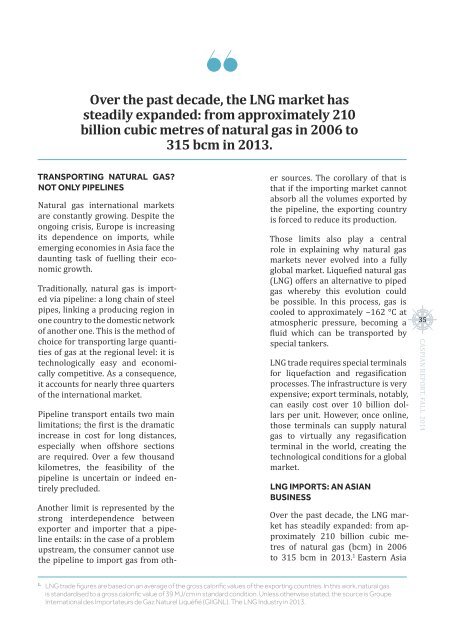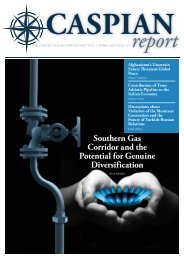Create successful ePaper yourself
Turn your PDF publications into a flip-book with our unique Google optimized e-Paper software.
Over the past decade, the LNG market has<br />
steadily expanded: from approximately 210<br />
billion cubic metres of natural gas in 2006 to<br />
315 bcm in 2013.<br />
TRANSPORTING NATURAL GAS<br />
NOT ONLY PIPELINES<br />
Natural gas international markets<br />
are constantly growing. Despite the<br />
ongoing crisis, Europe is increasing<br />
its dependence on imports, while<br />
emerging economies in Asia face the<br />
daunting task of fuelling their economic<br />
growth.<br />
Traditionally, natural gas is imported<br />
via pipeline: a long chain of steel<br />
pipes, linking a producing region in<br />
one country to the domestic network<br />
of another one. This is the method of<br />
choice for transporting large quantities<br />
of gas at the regional level: it is<br />
technologically easy and economically<br />
competitive. As a consequence,<br />
it accounts for nearly three quarters<br />
of the international market.<br />
Pipeline transport entails two main<br />
limitations; the first is the dramatic<br />
increase in cost for long distances,<br />
especially when offshore sections<br />
are required. Over a few thousand<br />
kilometres, the feasibility of the<br />
pipeline is uncertain or indeed entirely<br />
precluded.<br />
Another limit is represented by the<br />
strong interdependence between<br />
exporter and importer that a pipeline<br />
entails: in the case of a problem<br />
upstream, the consumer cannot use<br />
the pipeline to import gas from other<br />
sources. The corollary of that is<br />
that if the importing market cannot<br />
absorb all the volumes exported by<br />
the pipeline, the exporting country<br />
is forced to reduce its production.<br />
Those limits also play a central<br />
role in explaining why natural gas<br />
markets never evolved into a fully<br />
global market. Liquefied natural gas<br />
(LNG) offers an alternative to piped<br />
gas whereby this evolution could<br />
be possible. In this process, gas is<br />
cooled to approximately −162 °C at<br />
atmospheric pressure, becoming a<br />
fluid which can be transported by<br />
special tankers.<br />
LNG trade requires special terminals<br />
for liquefaction and regasification<br />
processes. The infrastructure is very<br />
expensive; export terminals, notably,<br />
can easily cost over 10 billion dollars<br />
per unit. However, once online,<br />
those terminals can supply natural<br />
gas to virtually any regasification<br />
terminal in the world, creating the<br />
technological conditions for a global<br />
market.<br />
LNG IMPORTS: AN ASIAN<br />
BUSINESS<br />
Over the past decade, the LNG market<br />
has steadily expanded: from approximately<br />
210 billion cubic metres<br />
of natural gas (bcm) in 2006<br />
to 315 bcm in 2013. 1 Eastern Asia<br />
35<br />
CASPIAN REPORT, FALL <strong>2014</strong><br />
1.<br />
LNG trade figures are based on an average of the gross calorific values of the exporting countries. In this work, natural gas<br />
is standardised to a gross calorific value of 39 MJ/cm in standard condition. Unless otherwise stated, the source is Groupe<br />
International des Importateurs de Gaz Naturel Liquéfié (GIIGNL), The LNG Industry in 2013.










